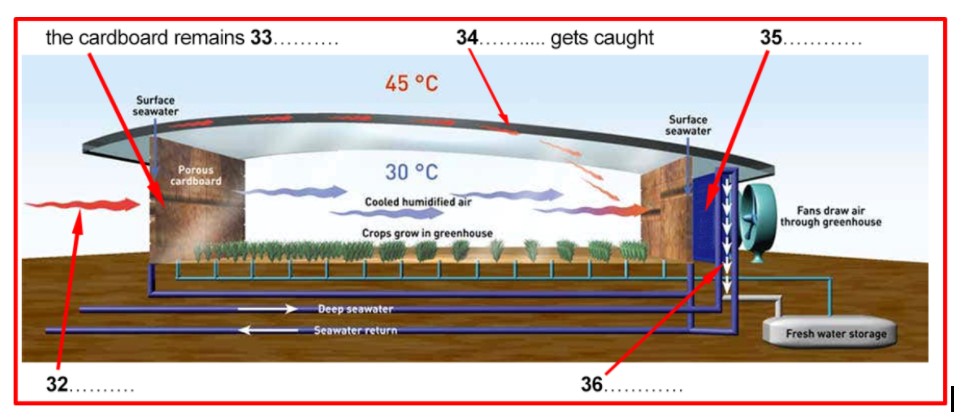IELTS Data Reading Passage 162 – The Rainmaker Design
You should spend about 20 minutes on Questions 27 – 40 which are based on IELTS Data Reading Passage 162 – The Rainmaker Design Reading Passage Below:-
The Rainmaker design
{A} SOMETIMES ideas just pop up out of the blue. Or in Charlie Paton’s case, out of the rain. ‘I was in a bus in Morocco traveling through the desert,’ he remembers. ‘It had been raining and the bus was full of hot, wet people. The windows steamed up and I went to sleep with a towel against the glass. When I woke, the thing was soaking wet. I had to wring it out. And it set me thinking. Why was it so wet?’
{B} The answer, of course, was condensation. Back home in London, a physicist friend, Philip Davies, explained that the glass, chilled by the rain outside, had cooled the hot humid air inside the bus below its dew point, causing droplets of water to form on the inside of the window. Intrigued, Paton–a lighting engineer by profession–started rigging up his own equipment. “I made my own solar stills. It occurred to me that you might be able to produce water in this way in the desert, simply by cooling the air. I wondered whether you could make enough to irrigate fields and grow crops.’
{C} Today, a decade on, his dream has taken shape as a giant greenhouse on a desert island off Abu Dhabi in the Persian Gulf–the first commercially viable version of his ‘seawater greenhouse’. Local scientists, working with Paton, are watering the desert and growing vegetables in what is basically a giant dew-making machine that produces fresh water and cool air from sun and seawater. In awarding Paton first prize in a design competition two years ago, Marco Goldschmied, president of the Royal Institute of British Architects, called it ‘a truly original idea which has the potential to impact on the lives of millions of people living in coastal water-starved areas around the world’.
{D} The seawater greenhouse as developed by Paton has three main parts. They both air-condition the greenhouse and provide water for irrigation. The front of the greenhouse faces the prevailing wind so that hot dry air blows in through a front wall. The wall is made of perforated cardboard kept moist by a constant trickle of seawater pumped up from the ocean. The purpose is to cool and moisten the incoming desert air. The cool moist air allows the plants to grow faster. And, crucially, because much less water evaporates from the leaves, the plants need much less moisture to grow than if they were being irrigated in the hot dry desert air outside the greenhouse.
{E} The air-conditioning of the interior of the greenhouse is completed by the second feature: the roof. It has two layers: an outer layer of clear polyethylene and an inner coated layer that reflects infrared radiation. This combination ensures that visible light can stream through to the plants, maximizing the rate of plant growth through photosynthesis but at the same time heat from the infrared radiation is trapped in the space between the layers, and kept away from the plants. This helps keep the air around the plants cool.
{F} At the back of the greenhouse sits the third element. This is the main water production unit. Here, the air hits a second moist cardboard wall that increases its humidity as it reaches the condenser, which finally collects from the hot humid air the moisture for irrigating the plants. The condenser is a metal surface kept cool by still more seawater. It is the equivalent of the window on Paton’s Moroccan bus. Drops of pure distilled water form on the condenser and flow into a tank for irrigating the crops.
{G} The Abu Dhabi greenhouse more or less runs itself. Sensors switch everything on when the sun rises and alter flows of air and seawater through the day in response to changes in temperature, humidity, and sunlight. On windless days, fans ensure a constant flow of air through the greenhouse. ‘Once it is tuned to the local environment, you don’t need anyone there for it to work,’ says Paton. ‘We can run the entire operation off one 13-amp plug, and in the future, we could make it entirely independent of the grid, powered from a few solar panels.’
{H} Critics point out that construction costs of around $4 a square foot are quite high. By illustration, however, Paton presents that it can cool as efficiently as a 500-kilowatt air conditioner while using less than 3 kilowatts of electricity. Thus the plants need only an eighth of the volume of water used by those grown conventionally. And so the effective cost of the desalinated water in the greenhouse is only a quarter that of water from a standard desalinator, which is good economics. Besides, it really suggests an environmentally-friendly way of providing air conditioning on a scale large enough to cool large greenhouses where crops can be grown despite the high outside temperatures.
Questions 27-31
Do the following statements agree with the claims of the writer in Reading Passage? In boxes 27-31 on your answer sheet, write
| YES | if the statement agrees with the writer |
| NO | if the statement does not agree with the writer |
| NOT GIVEN | if there is no information about this in the passage |
(27) The idea just came to Charlie Paton by accident.
(28) The bus was well ventilated.
(29) After waking up, Paton found his towel was wet.
(30) The fan in the bus did not work well.
(31) Paton immediately operated his own business in the Persian Gulf after talking with Philip Davies.
Questions 32-36
Label the diagram below.
Choose NO MORE THAN THREE WORDS from the passage for each answer.
Write your answers in boxes 32-36 on our answer sheet.
Questions 37-40
Summary Complete the summary below, using NO MORE THAN TWO WORDS from the Reading Passage for each answer.
Write your answers in boxes 37-40 on your answer sheet.
| To some extent, the Abu Dhabi greenhouse functions automatically. When the day is sunny, the equipment can respond to the changes in several natural elements. When there is no wind, 37……. helps to retain the flow of air. Even in the future, we have an ideal plan to power the greenhouse from 38………. However, there are still some critics who argue that 39……….are not good economics. To justify himself, Paton presents favourable arguments against these critics and suggests that it is an 40……..approach to provide air conditioning in a large-scale sense. |
IELTS Data Reading Passage 162 – The Rainmaker Design Answers
| 26 | CHILDREN | 34 | E |
| 27 | VI | 35 | D |
| 28 | IV | 36 | G |
| 29 | II | 37 | A |
| 30 | V | 38 | C |
| 31 | VII | 39 | B |
| 32 | F | 40 | C |
| 33 | B |

